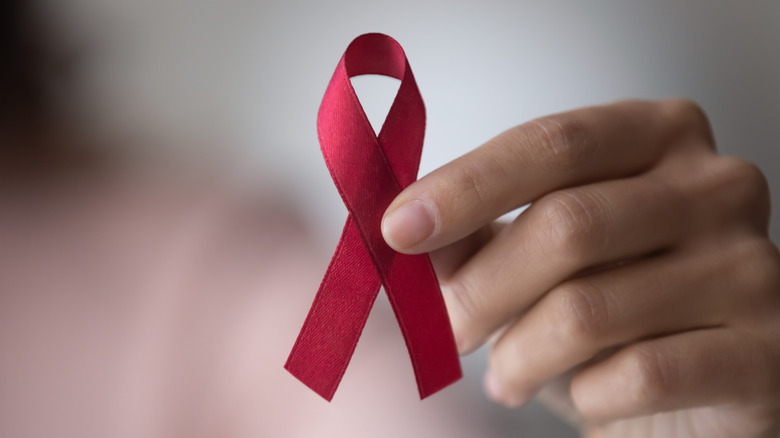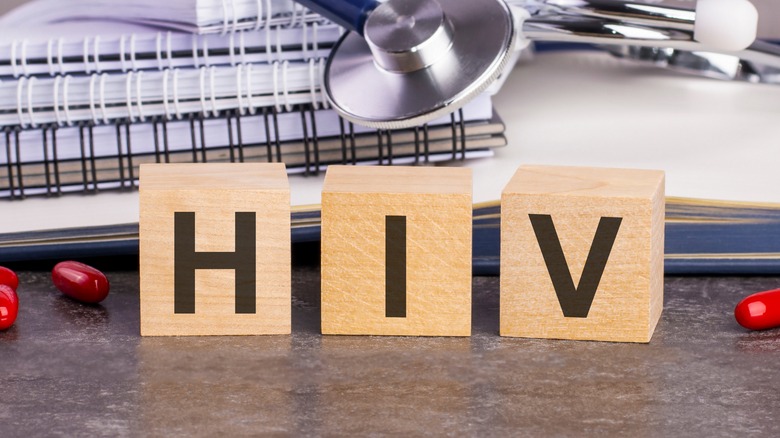Myths You Should Stop Believing About HIV/AIDS
Human immunodeficiency virus (HIV) is a virus that was initially discovered in 1981 (via Healthline). According to HIV.gov, the disease attacks white blood cells, which ultimately makes a person more vulnerable to other illnesses. Despite common belief, HIV and acquired immunodeficiency syndrome (AIDS) aren't the same thing, with the latter being a late stage of an HIV infection.
An HIV-positive person will develop AIDS when their immune system is damaged, as explained by the Centers for Disease Control and Prevention (CDC). Although there is currently no cure for HIV, the virus can be controlled with careful management and treatment, potentially leading to a long and healthy life, per the Mayo Clinic.
Despite there being treatment options nowadays, HIV/AIDS is still highly stigmatized. There are many myths that continue to surround both the virus and the condition. Realistically, while HIV and AIDS are very serious, there's no reason to be afraid of people who have either. Instead, it's best to educate yourself on existing misconceptions to have a better understanding on who can contract HIV, what it means for them, and how it's spread.
Myth: HIV and AIDS are the same
HIV and AIDS aren't actually the same disease. In fact, HIV is a virus, while AIDS is a condition, according to Healthline. This means that every AIDS patient has HIV, but not every patient who contracts HIV will develop AIDS (via Aidsmap).
There are three stages of HIV: acute HIV infection, chronic HIV infection, and AIDS (via the National Institutes of Health). Healthline states HIV may not always develop to its third stage. However, if HIV is left untreated, it can turn to AIDS within eight to 10 years, as explained by Mayo Clinic. With that said, thanks to HIV treatment options that are currently available, AIDS doesn't always occur in HIV-positive people.
HIV.gov explains that AIDS will develop when an HIV-positive person's immune system is badly damaged from the virus. The site also claims that most people in the U.S. won't go on to contract AIDS due to the different medications and treatments that are available.
Myth: Sex is the only way to contract HIV/AIDS
Although sex is one way to spread HIV/AIDS, it isn't the only method. HIV.gov states that HIV/AIDS can be transmitted by coming into direct contact with certain bodily fluids, such as blood, breast milk, vaginal fluids, rectal fluids, semen, and pre-seminal fluid. That being said, the CDC explains that anal sex poses the greatest risk to the spread of HIV/AIDS, especially if condoms aren't being used.
HIV/AIDS can also be transmitted from person to person by sharing needles or other drug injection equipment. A mother can spread HIV to her baby during labor, birth, or breastfeeding, otherwise known as perinatal transmission (via CDC).
In rarer cases, HIV can be transmitted via oral sex, receiving blood transfusions, being bitten by a person with HIV, deep, open-mouth kissing, or eating food that has already been chewed by someone who is HIV-positive, as noted by HIV.gov.
Myth: Gay men are the only people who can get HIV/AIDS
It's true that some minority groups are more at risk for contracting HIV/AIDS, with men who have sex with men (MSM) of all ethnicities and backgrounds being at the top (via CDC). According to the National Institute on Drug Use, 61% of HIV-positive people were infected via male-to-male sexual contact. However, MSM aren't the only people who are at risk for HIV/AIDS.
HIV.gov notes that communities with high HIV/AIDS rates can be exposed to the virus. Meanwhile, subpopulations (including African American and Latino people), transgender women who have sex with men, and people who inject drugs are all at risk, as stated by the CDC.
While some groups of people are at a higher risk, it's important to know that anyone can contract HIV/AIDS, including straight people and children. This is especially true for those who engage in what HIV.gov describes as risky behavior, by having sex with condoms or sharing needles or syringes with HIV-positive people.
Myth: HIV can't be treated
There's currently no cure for HIV/AIDS, but there are treatment options for HIV. According to the CDC, with proper treatment, most patients will be able to control the virus within half a year. The Mayo Clinic states that antiretroviral therapy (ART) typically describes two medications to lower the amount of HIV in a person's blood. Some of these anti-HIV drugs include non-nucleoside reverse transcriptase inhibitors (NNRTIs), protease inhibitors (PIs), and entry or fusion inhibitors. The CDC also notes that anti-HIV treatment can be provided in shot or pill form.
Additionally, the Mayo Clinic explains that different types of tests will be able to help HIV-positive people figure out which ART is best for them. Moreover, any person with HIV should start on ART, regardless of how far along the virus is. That being said, even with consistent use of ART, a person will always be HIV positive, even if HIV isn't detected in the body (via National Institutes of Health).
Myth: HIV/AIDS is airborne
Despite existing myths about HIV/AIDS being airborne, neither the virus or condition can be transmitted through the air. A person who is HIV-positive won't be able to spread it by breathing near someone else. Although HIV is indeed a virus like the cold or flu, as explained by WebMD, it's much harder to catch than your average illness.
This also means that you can't contract HIV from hugging a person who has it, or being around an HIV-positive person when they cough or sneeze. In other words, sweat, tears, vomit, and pee are also not carriers of HIV — and even if there's a small amount of blood present, there haven't been any reported cases of HIV being transmitted via vomit or pee (via WebMD). Even sharing utensils probably won't give you HIV.
Because HIV lives in the blood and some bodily fluids, you'd likely have to have sexual contact or exchange needles to be exposed, according to the National Health Services.
Myth: HIV always leads to AIDS
HIV and AIDS are often lumped together, but testing positive for HIV doesn't necessarily mean you have AIDS, nor does it indicate that you'll eventually contract it (via WebMD).
AIDS is late-stage HIV, and will likely occur when HIV hasn't been treated. It follows two other stages of HIV: acute HIV infection, which can occur between two and four weeks after the initial infection (from HIV.gov), and chronic HIV infection, considered to be the onset of AIDS when HIV starts to increase in the body (via HIV.gov).
That being said, Healthline explains that HIV doesn't always worsen drastically, especially if treatment begins early on. If an HIV-positive person starts ART shortly after receiving their diagnosis, the virus can be slowed down, via HIV.gov. MedlinePlus states that ART can make HIV a manageable chronic condition and reduces the risk of spreading it. According to WebMD, ART should be started within seven days of receiving an HIV diagnosis.
Myth: If you're using PrEP, you don't need condoms
Pre-exposure prophylaxis (PrEP) is a medication taken to prevent getting HIV. According to the CDC, it reduces the risk of receiving it from sex by 99% and from injection drug use by at least 74%. PrEP can be taken via shots or pills, and is recommended for those who had anal or vaginal sex with someone who is HIV-positive within the past 6 months, regularly inject drugs, or take post-exposure prophylaxis (PEP) and continue to engage in risky behavior (via the CDC). While PrEP can be an extremely effective way to reduce your risk of contracting HIV, it won't completely prevent transmission, and barrier methods of contraception should still be used.
According to PrEP Daily, using both condoms and PrEP can potentially provide the highest amount of protection from contracting HIV and other sexually transmitted infections (STIs). Additionally, Greater Than Aids explains that PrEP only works to prevent the spread of HIV, meaning people are still at risk for other STIs such as gonorrhea and chlamydia. Condoms can not only help avoid unplanned pregnancy, but other serious STIs.
Myth: HIV-positive people can't have children
Even if someone is HIV-positive, they can still safely have a child, according to the Office on Women's Health (OASH). However, it's still possible to spread HIV to the baby during pregnancy, labor, giving birth, or while breastfeeding.
That being said, there are ways to lower the risk of transmitting HIV during pregnancy. For instance, the OASH states that it's especially important to ensure parents are already on HIV treatment, along with getting prenatal care and managing side effects. They should also opt against breastfeeding and make sure that the baby is tested for HIV as soon as they're born.
Aidsmap also explains that after birth, the baby will most likely need to take anti-HIV drugs. The amount of time that they take the medications will depend on the parent's HIV treatment. Additionally, HIV tests will be administered on the baby multiple times (directly after birth, at six weeks, at 12 weeks, and at 18 months).
Myth: HIV means a person's life is over
According to Healthline, the life expectancy for a 20-year-old HIV-positive patient was 39 back in 1996. In 2011, the estimated age went up to around 70 years old. This means that while the outlook for HIV-positive people wasn't too bright throughout the 1980s and '90s, modern-day research and treatment help people with HIV live much longer, healthier lives.
In order to ensure an HIV-positive person can thrive, ART is an absolute must, via the National Institutes of Health (NIH). WebMD states that ART can make a person's viral load so low that a test won't even spot HIV. HIV will still be in the body, but the virus will have been dramatically slowed down. Still, ART won't cure HIV; nevertheless, HIV medicines can help HIV from multiplying, ultimately reducing the viral load in the body, according to the NIH.
The numbers support this idea as well: A study done by Our World In Data even found that in 2016, 1.2 million deaths were avoided thanks to ART.
Myth: You can tell if someone's HIV-positive just by looking at them
It's a common myth that you can tell whether or not someone has HIV just by looking at them. There's a stereotype that HIV/AIDS-positive people look sick, thin, gaunt, or weak. However, most of the time, people who have HIV look like anyone else, and the only way to tell if someone has HIV is by taking a test (via HIV.gov). Common symptoms of HIV can include fever, headache, fatigue, weight loss, and rash, as stated by the Mayo Clinic.
In a similar vein, although AIDS is a more severe progression of HIV, you still can't tell someone has it just by taking a glance at them. With that said, some symptoms of AIDS to watch out for are sweats, chills, fever, diarrhea, fatigue, and lesions on the tongue or in the mouth (via the Mayo Clinic).
It's important not to stereotype people who have HIV/AIDS. Assuming that a person has HIV or AIDS contributes to harmful stigmas surrounding at-risk communities.











